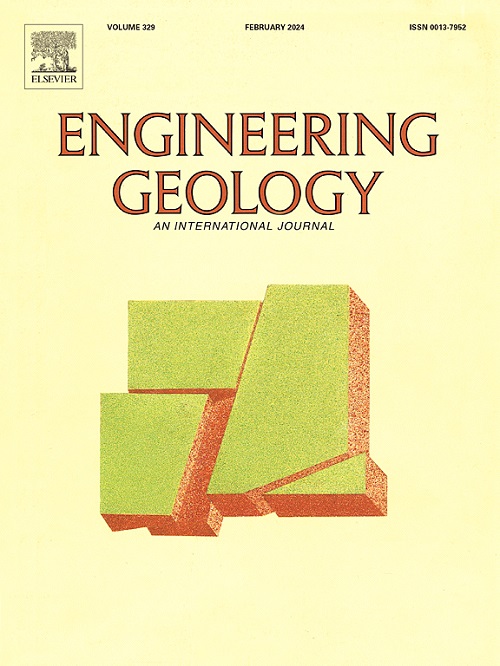海洋粘土循环降解和孔隙压力积累的阈值剪切应变:工程应用的见解和模型
IF 8.4
1区 工程技术
Q1 ENGINEERING, GEOLOGICAL
引用次数: 0
摘要
海相粘土的阈值剪切应变代表了复杂海洋动力环境下的基本土壤特征。这些数值的精确估算为海洋工程项目的推进和地质灾害的防治提供了定量设计依据。对海相粘土进行了一系列等体积多级应变控制循环直接单剪试验。考虑初始有效固结压力(σv0′)和加载频率(f)的影响,研究了循环剪切过程中循环退化阈值剪切应变(γtd)和超孔隙水压力积累(γtp)。结果表明:σv0′和σv0′的增大对刚度退化的幅度和进展速度以及超孔隙水压力的积累均有显著的抑制作用;然而,σv0′的增大减小了f的影响,表明临界σv0′的存在使得试验海洋粘土的循环响应对f相对不敏感。建立了结合电双层理论的微力学框架,从力学角度解释孔隙压力累积的频率衰减。γ - td和γ - tp均随σv0′的增大而增大,但与f无关,其中γ - tp显著大于γ - td。在此基础上,提出了不同IP和σv0′黏土γtd和γtp的评价模型。该方法评价了考虑土体循环退化对结构动力响应影响的必要性,为工程施工实践提供了重要参考。本文章由计算机程序翻译,如有差异,请以英文原文为准。
Threshold shear strain for cyclic degradation and pore pressure accumulation in marine clay: Insights and models for engineering applications
Threshold shear strains of marine clays represent essential soil characteristics within intricate marine dynamic settings. Precise estimation of these values provides a quantitative design basis for the advancement of marine engineering projects and geological disaster prevention. A series of constant-volume multistage strain-controlled cyclic direct simple shear tests were performed on marine clay. Consequently, the threshold shear strains for cyclic degradation (γtd) and excess pore water pressure accumulation (γtp) during cyclic shearing were investigated by considering the effects of the initial effective consolidation pressure (σv0′) and loading frequency (f). The results demonstrate that an increase in σv0′ and f exhibits significant suppression effects on both the magnitude and progression rate of stiffness degradation, as well as the accumulation of excess pore water pressure. Nevertheless, the increase of σv0′ diminishes the effect of f, indicating that the existence of a critical σv0′ makes the cyclic response of the tested marine clay relatively insensitive to f. A micromechanical framework incorporating the electrical double-layer theory was established to mechanistically interpret the frequency-dependent attenuation of pore pressure accumulation. Furthermore, both γtd and γtp increase with σv0′, while remaining independent of f, with γtp being notably larger than γtd. Consequently, evaluation models of γtd and γtp for clays with various IP and σv0′ are proposed based on previously published data. This approach serves as a crucial reference for engineering construction practices by evaluating the necessity of considering the effect of soil cyclic degradation on the dynamic response of structures.
求助全文
通过发布文献求助,成功后即可免费获取论文全文。
去求助
来源期刊

Engineering Geology
地学-地球科学综合
CiteScore
13.70
自引率
12.20%
发文量
327
审稿时长
5.6 months
期刊介绍:
Engineering Geology, an international interdisciplinary journal, serves as a bridge between earth sciences and engineering, focusing on geological and geotechnical engineering. It welcomes studies with relevance to engineering, environmental concerns, and safety, catering to engineering geologists with backgrounds in geology or civil/mining engineering. Topics include applied geomorphology, structural geology, geophysics, geochemistry, environmental geology, hydrogeology, land use planning, natural hazards, remote sensing, soil and rock mechanics, and applied geotechnical engineering. The journal provides a platform for research at the intersection of geology and engineering disciplines.
 求助内容:
求助内容: 应助结果提醒方式:
应助结果提醒方式:


